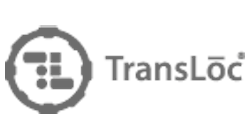TransLoc hit the ground running in 2017 and never looked back, experiencing momentous growth across the board, garnering substantial interest in its transit agency-centric approach to microtransit, expanded partnerships – including Google — and its innovative predictive modeling and microtransit pilot programs.
2017 Highlights
● Finalized partnership with tech giant Google to further ensure accurate integration of public transit information with Google Maps
● New transit agency partnerships broaden TransLoc’s reach and provide foundation for further growth
● Hailed by Fast Company as one of the most innovative companies in transportation in 2017
● Injected knowledge and experience with addition of Maker City Founder Peter Hirshberg, along with mobility visionary Gabe Klein, top transportation official for Chicago and Washington, D.C.
“We’ve had the right talent, the right technological solution, and the right go-to market strategy, but our unprecedented success this year and broader industry paradigm shift confirm that now is the right time,” said TransLoc CEO Doug Kaufman. “2018 will be a banner year for microtransit.”
TransLoc recently added Tri-Delta Transit and Sacramento Regional Transit District to its growing roster of municipal transit agencies leveraging the MicroTransit Simulator as part of their deployment process, including three in California: Orange County Transportation Authority, Central Contra Costa Transit Authority and the San Joaquin Regional Transit District.
“This year, in response to the growing appetite for microtransit services and the associated challenges facing public agencies, we developed a unique consultative, agency-centric approach,” said Kaufman. “Our three-step data-driven method has enabled TransLoc to successfully support a record number of transit agencies as they deliver flexible, demand-driven transit options.”
TransLoc projects a 600 percent increase in live pilots in 2018.
The MicroTransit Simulator
TransLoc's MicroTransit Simulator is the first crucial step for agencies. Launched this year, the predictive modeling approach arms agencies with the right data and clear insights necessary to craft a smart plan to bring microtransit to their communities.
Each city is unique, as are the transit requirements of their communities. This creates a complex set of challenges for transit agencies interested in deploying microtransit. Understanding how best to serve their riders while minimizing the risks of introducing these new transit services is at the core of TransLoc’s MicroTransit Simulator. Since its debut in July, over 100 cities are in conversation with TransLoc about leveraging the Simulator, which uses big data and TransLoc’s market-tested scheduling algorithm to create predictive models for successful microtransit services before a single vehicle even hits the road.
“TransLoc doesn’t just drop technology in the laps of transit agencies. We’re committed to being a true partner through every step of the microtransit implementation process. It’s imperative that transit agencies remain at the center of a microtransit solution,” said Kaufman. “Our partnerships with transit agencies ultimately help riders get where they need to go by increasing coverage, improving accessibility, and by providing a more responsive, demand-driven service.”
The MicroTransit Accelerator
In September, TransLoc launched the MicroTransit Accelerator, a national competition intent on encouraging the adoption of demand-driven, flexible transit offered by transit agencies and municipalities to better serve their communities. From a field of submissions representing some of the most innovative municipal transit agencies across the nation, the Office of Mobility Innovation in the City of Detroit and the Metropolitan Atlanta Rapid Transit Authority took top honors, followed by Lane Transit in Lane County Oregon, Pace Bus in the metropolitan Chicago area and Airport Corridor Transportation Association (ACTA).
New Partnerships
The Google Partnership
The rapid and widespread adoption of TransLoc’s Architect product prompted the forging of a new partnership with Google to further ensure accurate integration of public transit information with Google Maps, at no cost to the public transit agency. This partnership has allowed TransLoc to manage larger volumes of real-time transit information for agencies.
With more robust information, smart cities are now beginning to harness Architect to develop community-based transit options such as on-demand microtransit services. TransLoc Architect is currently used by more than 150 transit agencies.
New Strategic Advisors
TransLoc expanded its team of strategic advisers this year to include industry veterans Gabe Klein and Peter Hirshberg. Gabe is the former transportation chief for the cities of Washington, D.C. and Chicago and is one of the nation’s leading voices for urban mobility. Peter is the creator of the Maker City Project, a national organization working with more than 100 U.S. cities and towns for smart city development. Both are working closely with TransLoc to further deliver on the promise of sustainable transportation and the smart cities of the future.
Industry Recognition
Fast Company’s “Most Innovative Company”
TransLoc kicked off 2017 being named one of Fast Company’s Most Innovative Companies in transportation. The annual list honors leading enterprises and rising newcomers that exemplify impactful innovation. The magazine recognized TransLoc for making “getting around easier, no matter where you are or what your situation” and highlighted its approach to client partnerships in the public sector.


